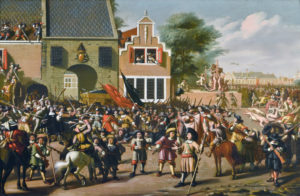A particularly grim day in history
1672
The murder of Jan de Witt
Jan de Witt was the leading Dutch politician of his age, known for his opposition to the Orange family’s dynasty in his country. After a series of military defeats Jan and his brother Cornelis were set upon by a well-organized mob in The Hague, tortured, murdered, and, then cannibalized. De Witt’s supporters and most historians blame William of Orange for instigating the violence. William later assumed the throne of the Netherlands and England.
1940
The attack on Leon Trotsky
The creator of the Red Army, the instigator of the Red Terror, and brilliant Marxist theoretician, Leon Trotsky was one of the chief architects of the Bolshevik success in the Russian Revolution. He fell out, however, with Joseph Stalin and was exiled from the Soviet Union in 1929. Stalin’s wrath was not pacified by Trotsky’s absence and the dictator continued to seek his rival’s destruction, condemning him in absentia to death in a show trial. A couple of murderous attempts on his life during Trotsky’s exile in Mexico had failed but in August, 1940 Ramón Mercader, a KGB agent, struck him with an ice axe, causing his death the next day.
1968
The end of the Prague Spring
Under Premier Alexander Dubcek, the Czechoslovakian Communist party had attempted a policy of relaxing controls on freedom of expression, producing more consumer goods, and hinting at multi-party democracy. This “socialism with a human face” aroused fears among Party hardliners and their masters in Moscow. Fearing lest Dubcek’s ideas spread, Soviet leader Brezhnev ordered an invasion of Czechoslovakia by Warsaw Pact forces. Under the pretext of foiling a pro-Western coup, 20,000 troops and 2,000 tanks from the USSR, Poland, and East Germany crossed the borders and took control of the country. Dubček was deposed, replaced by a hard-liner, expelled from the Communist Party and given a job as a forestry official. His reforms were undone but his example seems to have inspired Soviet thinkers 20 years later in the period of glasnost.


